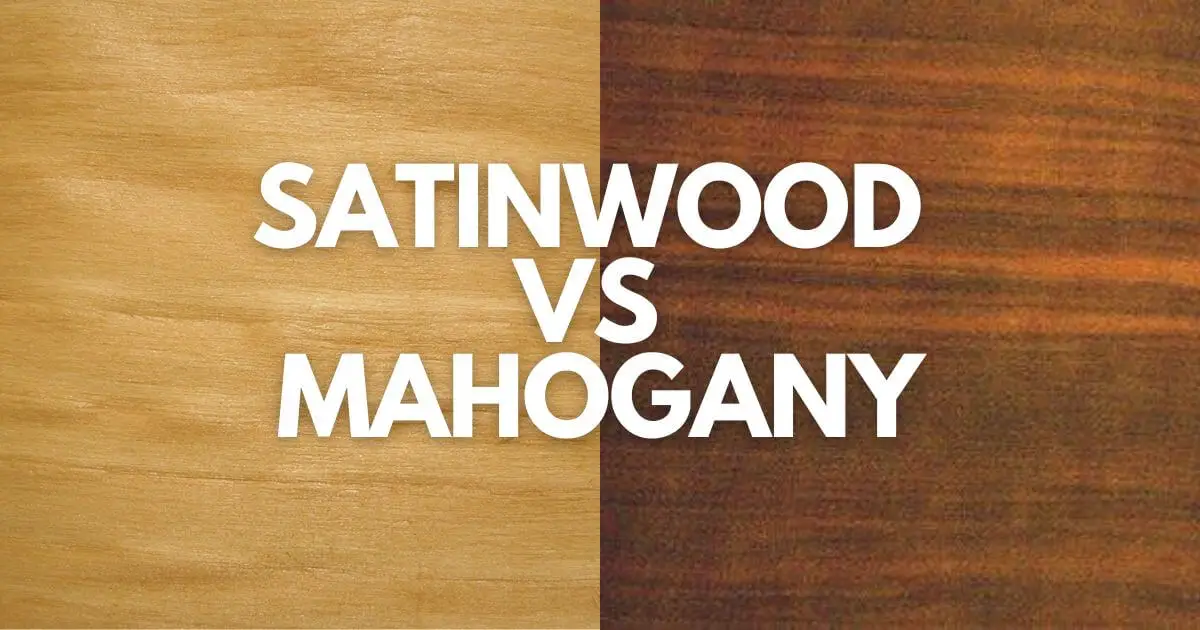Satinwood and Mahogany are beautiful and popular hardwoods for making high-quality furniture and musical instruments.
Satinwood is light yellow-brown in color. It has a fine, uniform texture and a straight grain, while Mahogany is a deep reddish-brown color that darkens over time. It has a medium to coarse texture and straight to interlocked grain.
Both satinwood and mahogany woods are known for their durability, but Mahogany is more resistant to decay and rot than satinwood.
What is Satinwood?
Satinwood is a hardwood tree native to various regions of Asia, including India, Sri Lanka, Indonesia, and Malaysia. It is known for its durability and hardness and is often used for high-quality furniture, musical instruments, and decorative items.
What is Mahogany Wood?
Mahogany is a type of hardwood that comes from several different species of the genus Swietenia. It is native to tropical regions of the Americas, including Central and South America, and is prized for its durability, beauty, and efficiency.
Mahogany wood is popular for its reddish-brown color and straight, even grain. Its medium texture makes it ideal for making furniture, flooring, and musical instruments. Mahogany is also resistant to rot and insect infestation, making it a popular choice for outdoor applications such as deck and boat building.
| # | Satinwood | Mahogany wood |
| Scientific name | Chloroxylon swietenia | Swietenia mahagoni |
| Tree Size | 40-50 ft (12-15 m) tall, 1-1.5 ft (.3-.5 m) trunk diameter | 65-100 ft (20-30 m) tall, 2-3 ft (.6-1.0 m) trunk diameter |
| Hardness | Very hard | Moderately hard |
| Insect Resistant | Susceptible to insect attack. | Resistant to Rot and incest |
| Durability | Moderately Durable | Extreme Durable |
| Wood Type | Hardwood | Hardwood |
| Odor | Pleasing scent when being worked | Spicy scent when being worked |
Uses
Satinwood is commonly used for veneers, musical instruments, and small wooden decorative items. Mahogany is often used in high-end furniture, cabinetry, and boat building.
Satinwood can be used for making furniture, but Mahogany is the preferable wood because Mahogany has a better finish and can withstand the external environment.
Durability
Both satinwood and mahogany are renowned for their durability, but mahogany is a much harder and more durable wood. Mahogany is naturally more resistant to decay and rot than satinwood. Hence mahogany requires less maintenance as compared to satinwood.
Cost
Mahogany Wood is more expensive than Satinwood because of its high-quality and great appearance. Mahogany is found in a limited area and is a slow-growing tree.
Workability
Satinwood is relatively difficult to work with; it is harder and heavier than mahogany. Satinwood caused a tearout while planing operations. Mahogany is much easier to carve and turn than satinwood, but mahogany’s interlocking grain is difficult to work with for beginners.
Hardness
There are several species of satinwood and mahogany wood, each with different hardness and weight. The table below lists the hardness of several species of satinwood and mahogany for comparison.
| Wood Species | Janka Hardness |
| African mahogany | 850 lbf (3,800 N) |
| Honduran mahogany | 900 lbf (4,020 N) |
| Cuban Mahogany | 930 lbf (4,120 N) |
| Swamp Mahogany | 1,250 lbf (5,540 N) |
| West Indian Satinwood | 1,820 lbf (8,100 N) |
| Santos Mahogany | 2,400 lbf (10,680 N) |
| East Indian Satinwood | 2,620 lbf (11,650 N) |
| Mountain Mahogany | 3,200 lbf (14,230 N) |
Allergies
Satinwood has been reported as a sensitizer, which can cause eye and skin irritation when working with it. Working with mahogany can also cause problems like skin irritation. So you need to be careful while working with this type of wood.
FAQ
Is Satinwood Good For Doors?
Yes, Satinwood is a hardwood species known for its durability and stability. It is also resistant to scratches and dents, making it a good choice for various furniture, windows, and doors.
Which is Waterproof? Satinwood or Mahogany Wood
Satinwood and Mahogany Wood are not waterproof, but Mahogany is more water resistant than Satinwood and can withstand moisture or outdoor environment for a long time. We need to understand that no wood species is completely waterproof. Some woods perform well in moisture.

